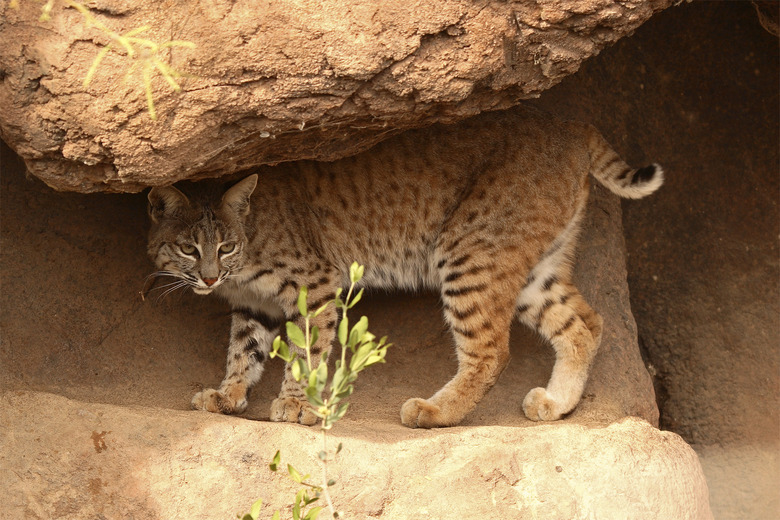Animals In The Desert Ecosystem
The hot desert ecosystem may be among the harshest living conditions in the world, with an average daytime temperature of 100 degrees Fahrenheit and less than less than 250 mm of rainfall per year. However, a large number of animals, reptiles, birds and insects have gone through desert adaptations to be able to survive and thrive in this hot, dry world. Animals that call the desert their home include rabbits, wild cats, roadrunners, geckos and beetles.
Animals in the Desert
Animals in the Desert
Desert animals include rabbits and wild cats. The most common desert rabbit is the fast, long-eared jackrabbit. Female jackrabbits can have several litters each year, with each litter consisting of at least six bunnies. Mountain lions and bobcats are two of the most well-known wild cats in the desert ecosystem. Mountain lions feed on mule deer and other small mammals, using caves to rest and sleep. They are solitary animals, and they can go without water for long periods of time. Bobcats are smaller than mountain lions and have short, bobbed tails and tufts of fur on their ears to improve their hearing. Desert bobcats chase prey from the ground, trees and rocks.
Reptiles in the Desert
Reptiles in the Desert
Many desert ecosystem locations are home to snakes, including rattlesnakes, coral snakes and king snakes. The venomous rattlesnakes shake their tails to send warnings. The brightly colored coral snakes are even more venomous than rattlesnakes. King snakes come in a wide range of colors and can eat venomous snakes because they have a special enzyme to break down the poison. Lizards are also abundant in the desert, such as horned lizards, banded geckos and tree lizards. Horned lizards have spines and horns and eat only ants and bugs. Banded geckos are the smallest geckos, weighing a mere two grams. When under threat, they mimic a scorpion, whipping their tail to fend off enemies. Tree lizards stand out with their unusually bright throats.
Birds in the Desert
Birds in the Desert
Common desert birds include the roadrunner, the vulture and the golden eagle. The roadrunner runs at high speeds to catch prey or escape danger. It can fly, but only if absolutely necessary. The vulture is a famous scavenger, with a very strong sense of smell. When a vulture identifies a carcass it circles the air before landing to feed. The golden eagle, named for the golden feathers around its head and neck, prefers to hunt in open terrain and feeds mainly on small rodents.
Insects in the Desert
Insects in the Desert
Many deserts have more insect species than all other animal groups combined. Insects common to deserts include beetles, grasshoppers, ants, bees and butterflies. They have developed many adaptations and behaviors to help them survive heat, drought and predators in the desert. For example, the thick exoskeletons of beetles help minimize water loss, and the cavities beneath their forewings trap moisture. Butterflies bring color to the desert. Common desert butterfly species include the Monarch, the Painted Lady, the Whites and Sulphurs, and the Gossamer Wings.
Cite This Article
MLA
Gillespie, Claire. "Animals In The Desert Ecosystem" sciencing.com, https://www.sciencing.com/animals-desert-ecosystem-6786031/. 25 July 2018.
APA
Gillespie, Claire. (2018, July 25). Animals In The Desert Ecosystem. sciencing.com. Retrieved from https://www.sciencing.com/animals-desert-ecosystem-6786031/
Chicago
Gillespie, Claire. Animals In The Desert Ecosystem last modified August 30, 2022. https://www.sciencing.com/animals-desert-ecosystem-6786031/
